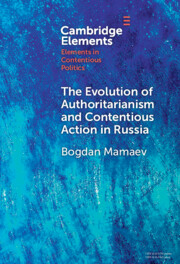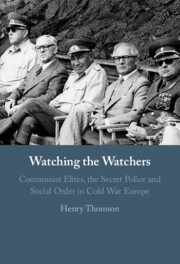131 results
1 - All Gray
-
- Book:
- Streetscapes of War and Revolution
- Published online:
- 30 May 2024
- Print publication:
- 06 June 2024, pp 22-68
-
- Chapter
- Export citation
39 - Repression, Sublimation, and Latency from Charles Brockden Brown to James Purdy
- from How to Recognize the Queer Past before (and during) the Advent of Medicalization
-
-
- Book:
- The Cambridge History of Queer American Literature
- Published online:
- 17 May 2024
- Print publication:
- 06 June 2024, pp 705-720
-
- Chapter
- Export citation

The Evolution of Authoritarianism and Contentious Action in Russia
-
- Published online:
- 30 May 2024
- Print publication:
- 20 June 2024
-
- Element
- Export citation
6 - The Public Square and the Body under Authoritarian Pressures
-
- Book:
- The Kazakh Spring
- Published online:
- 16 May 2024
- Print publication:
- 23 May 2024, pp 194-219
-
- Chapter
- Export citation
11 - The Reception of the Protestant Reformation in the Iberian Peninsula
-
-
- Book:
- Reformations Compared
- Published online:
- 14 March 2024
- Print publication:
- 21 March 2024, pp 242-265
-
- Chapter
- Export citation
State Violence and Pains of Punishment: Experiences of Incarcerated Women in Belarus in the Aftermath of the 2020 Protests
-
- Journal:
- Nationalities Papers , FirstView
- Published online by Cambridge University Press:
- 08 March 2024, pp. 1-17
-
- Article
-
- You have access
- Open access
- HTML
- Export citation
2 - A Theory of Elite Cohesion, Coercive Capacity, and Authoritarian Social Order
- from Part I - Introduction and Theory
-
- Book:
- Watching the Watchers
- Published online:
- 22 February 2024
- Print publication:
- 29 February 2024, pp 45-90
-
- Chapter
- Export citation
7 - Post-Stalinist Transitions, Elite Cohesion, and Coercive Agent Tenure
- from Part III - Cross-national Quantitative Analysis
-
- Book:
- Watching the Watchers
- Published online:
- 22 February 2024
- Print publication:
- 29 February 2024, pp 188-222
-
- Chapter
- Export citation
3 - Introduction to Part II
- from Part II - Comparative Historical Analysis: Polish People’s Republic and the German Democratic Republic
-
- Book:
- Watching the Watchers
- Published online:
- 22 February 2024
- Print publication:
- 29 February 2024, pp 93-99
-
- Chapter
- Export citation
5 - The German Democratic Republic
- from Part II - Comparative Historical Analysis: Polish People’s Republic and the German Democratic Republic
-
- Book:
- Watching the Watchers
- Published online:
- 22 February 2024
- Print publication:
- 29 February 2024, pp 140-172
-
- Chapter
- Export citation
6 - Introduction to Part III
- from Part III - Cross-national Quantitative Analysis
-
- Book:
- Watching the Watchers
- Published online:
- 22 February 2024
- Print publication:
- 29 February 2024, pp 175-187
-
- Chapter
- Export citation
9 - Conclusion
- from Part IV - Conclusion
-
- Book:
- Watching the Watchers
- Published online:
- 22 February 2024
- Print publication:
- 29 February 2024, pp 255-266
-
- Chapter
- Export citation
1 - Introduction
- from Part I - Introduction and Theory
-
- Book:
- Watching the Watchers
- Published online:
- 22 February 2024
- Print publication:
- 29 February 2024, pp 3-44
-
- Chapter
- Export citation
4 - The Polish People’s Republic
- from Part II - Comparative Historical Analysis: Polish People’s Republic and the German Democratic Republic
-
- Book:
- Watching the Watchers
- Published online:
- 22 February 2024
- Print publication:
- 29 February 2024, pp 100-139
-
- Chapter
- Export citation
8 - Chekists and Secret Informants: Post-Stalinist Transitions, Elite Cohesion, and Coercive Capacity
- from Part III - Cross-national Quantitative Analysis
-
- Book:
- Watching the Watchers
- Published online:
- 22 February 2024
- Print publication:
- 29 February 2024, pp 223-252
-
- Chapter
- Export citation

Watching the Watchers
- Communist Elites, the Secret Police and Social Order in Cold War Europe
-
- Published online:
- 22 February 2024
- Print publication:
- 29 February 2024
7 - Colonizing the State
- from Part III - Making a Slave Society
-
- Book:
- Lucky Valley
- Published online:
- 11 January 2024
- Print publication:
- 22 February 2024, pp 313-371
-
- Chapter
- Export citation
When Does Lethal Repression Fail? Unarmed Militancy and Backfire in Bolivia, 1982–2021
-
- Journal:
- Journal of Latin American Studies / Volume 56 / Issue 1 / February 2024
- Published online by Cambridge University Press:
- 04 April 2024, pp. 1-36
- Print publication:
- February 2024
-
- Article
-
- You have access
- Open access
- HTML
- Export citation
7 - Growth with Equity?
-
- Book:
- The Tortuous Path of South Korean Economic Development
- Published online:
- 07 December 2023
- Print publication:
- 21 December 2023, pp 198-238
-
- Chapter
- Export citation
4 - The Micro-sociology of Nonviolent Resistance
-
- Book:
- The Micro-Sociology of Peace and Conflict
- Published online:
- 26 October 2023
- Print publication:
- 09 November 2023, pp 104-131
-
- Chapter
-
- You have access
- Open access
- HTML
- Export citation



